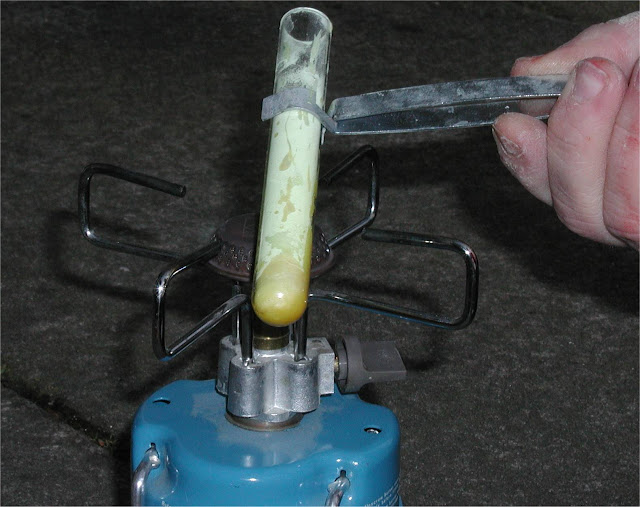Later, when I have done some suitably stitch counting research I will put up a little piece on sulphur matches but in the mean time I thought I'd put up a mini tutorial on making users rather than the precise historically accurate variations I intend to do.
Since all the local tobacconists only had coloured spills and I've yet to replicate some accurate copies from deal and pine (the two most common woods used as far as I can find) all I had to hand was a bunch of coffee stirrers from Tescos cafe that folk had proffed for me to use as paint stirrers

Spills and any other roughly split wood works better than smooth stuff but the sulphur will still adhere to things like lolly sticks well enough.
To make a batch pointed at both ends quickly I used a sanding machine.

Most originals were wider, pointed seems to be the most common shape but the Bryant and May collection lists flat ended, square section and of all sizes but more of that when I do the article proper.

The weather being suitable I dragged myself into the garden and Jnr took some pics of me coating the tips.
First off I three quarter filled a test tube with sulphur powder. A thin stick or wire was most useful in unclogging the funnel.

The wind was too strong for the meths burner from the chemistry set so I used the good old camping gaz stove to slowly melt the sulphur until it went runny.

Please google the safety precautions for working with sulphur. I ensured it was pointing away from me as I melted it and that a stiff breeze was blowing any fumes away from me. The liquid turned brown but the dipped matches went back more or less the yellow of the powder when they cooled. Gentle shakes ensured the gloop stayed runny for longer between heatings as the surface thickened faster than the bottom part. I'm not sure about this but it seemed at one point that if you applied too much heat it went redder, syrupy and, rather than heat it up more, it went runny again as it cooled? Is that right ye chemists out there? Anyway it kept going with the odd top up and reheating.
A quick dip at each end was all that was required

If it had cooled too much you ended up with the above. Oops!
It took about thirty minutes to dip this batch, it would be much easier with a bigger container but a test tube and a small amount of sulphur was all I had.

And the proof of the pudding, apply to a smouldering bit of char and you get this:

I thank you, and goodnight!
ATB
Tom
Since all the local tobacconists only had coloured spills and I've yet to replicate some accurate copies from deal and pine (the two most common woods used as far as I can find) all I had to hand was a bunch of coffee stirrers from Tescos cafe that folk had proffed for me to use as paint stirrers

Spills and any other roughly split wood works better than smooth stuff but the sulphur will still adhere to things like lolly sticks well enough.
To make a batch pointed at both ends quickly I used a sanding machine.

Most originals were wider, pointed seems to be the most common shape but the Bryant and May collection lists flat ended, square section and of all sizes but more of that when I do the article proper.

The weather being suitable I dragged myself into the garden and Jnr took some pics of me coating the tips.
First off I three quarter filled a test tube with sulphur powder. A thin stick or wire was most useful in unclogging the funnel.

The wind was too strong for the meths burner from the chemistry set so I used the good old camping gaz stove to slowly melt the sulphur until it went runny.

Please google the safety precautions for working with sulphur. I ensured it was pointing away from me as I melted it and that a stiff breeze was blowing any fumes away from me. The liquid turned brown but the dipped matches went back more or less the yellow of the powder when they cooled. Gentle shakes ensured the gloop stayed runny for longer between heatings as the surface thickened faster than the bottom part. I'm not sure about this but it seemed at one point that if you applied too much heat it went redder, syrupy and, rather than heat it up more, it went runny again as it cooled? Is that right ye chemists out there? Anyway it kept going with the odd top up and reheating.
A quick dip at each end was all that was required

If it had cooled too much you ended up with the above. Oops!
It took about thirty minutes to dip this batch, it would be much easier with a bigger container but a test tube and a small amount of sulphur was all I had.

And the proof of the pudding, apply to a smouldering bit of char and you get this:

I thank you, and goodnight!
ATB
Tom
Last edited:


